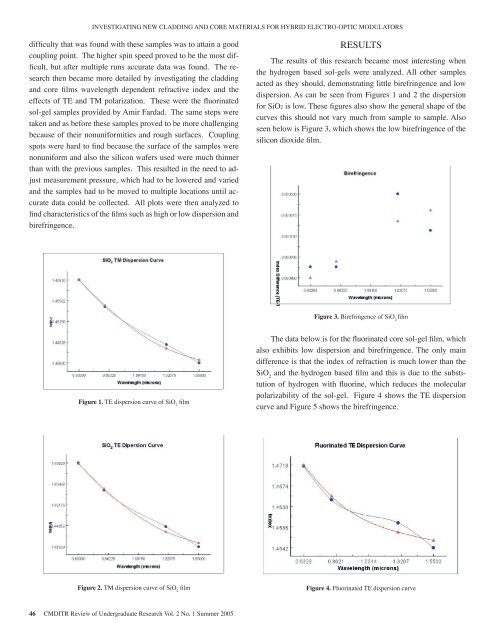Student Project Abstracts 2005 - Pluto - University of Washington
Student Project Abstracts 2005 - Pluto - University of Washington
Student Project Abstracts 2005 - Pluto - University of Washington
You also want an ePaper? Increase the reach of your titles
YUMPU automatically turns print PDFs into web optimized ePapers that Google loves.
INVESTIGATING NEW CLADDING AND CORE MATERIALS FOR HYBRID ELECTRO-OPTIC MODULATORSdifficulty that was found with these samples was to attain a goodcoupling point. The higher spin speed proved to be the most difficult,but after multiple runs accurate data was found. The researchthen became more detailed by investigating the claddingand core films wavelength dependent refractive index and theeffects <strong>of</strong> TE and TM polarization. These were the fluorinatedsol-gel samples provided by Amir Fardad. The same steps weretaken and as before these samples proved to be more challengingbecause <strong>of</strong> their nonuniformities and rough surfaces. Couplingspots were hard to find because the surface <strong>of</strong> the samples werenonuniform and also the silicon wafers used were much thinnerthan with the previous samples. This resulted in the need to adjustmeasurement pressure, which had to be lowered and variedand the samples had to be moved to multiple locations until accuratedata could be collected. All plots were then analyzed t<strong>of</strong>ind characteristics <strong>of</strong> the films such as high or low dispersion andbirefringence.RESULTSThe results <strong>of</strong> this research became most interesting whenthe hydrogen based sol-gels were analyzed. All other samplesacted as they should, demonstrating little birefringence and lowdispersion. As can be seen from Figures 1 and 2 the dispersionfor SiO2 is low. These figures also show the general shape <strong>of</strong> thecurves this should not vary much from sample to sample. Alsoseen below is Figure 3, which shows the low birefringence <strong>of</strong> thesilicon dioxide film.Figure 3. Birefringence <strong>of</strong> SiO 2filmFigure 1. TE dispersion curve <strong>of</strong> SiO 2filmThe data below is for the fluorinated core sol-gel film, whichalso exhibits low dispersion and birefringence. The only maindifference is that the index <strong>of</strong> refraction is much lower than theSiO 2and the hydrogen based film and this is due to the substitution<strong>of</strong> hydrogen with fluorine, which reduces the molecularpolarizability <strong>of</strong> the sol-gel. Figure 4 shows the TE dispersioncurve and Figure 5 shows the birefringence.Figure 2. TM dispersion curve <strong>of</strong> SiO 2filmFigure 4. Fluorinated TE dispersion curve46 CMDITR Review <strong>of</strong> Undergraduate Research Vol. 2 No. 1 Summer <strong>2005</strong>




